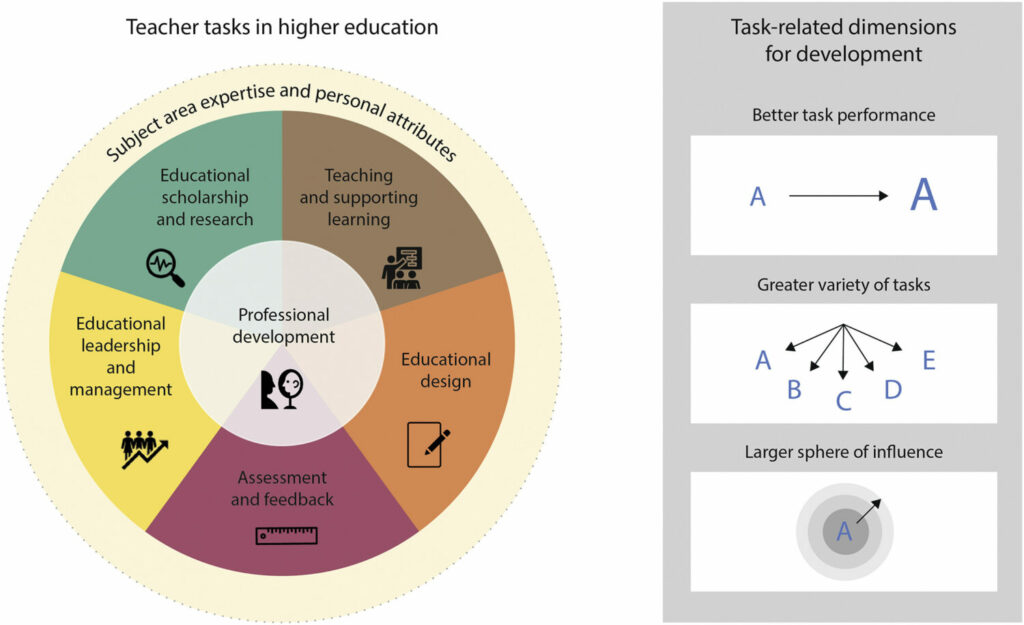With a teaching philosophy, you can reflect on your teaching in a structured way. This reflection is an essential part of the development of teaching expertise. At the same time, it serves to externally present your own teaching competency (e.g. in application processes). This blog post discusses which aspects of teaching are important for this and how they can be reflected upon in a theoretically well-founded way.
Experience is an essential foundation for experts in every domain – including teaching. As a general rule of thumb, it can be assumed that the gathering of experience takes about ten years.
At the same time, it is in no way guaranteed and self-evident that long-term professional experience necessarily leads to expertise. The essential prerequisite is much more that one’s own experience is reflected upon and thereby made useful for future application scenarios. Gruber (2021) even refers to reflection as the royal road for the development of expertise.
Reflection can take place in many different ways. However, any appropriate method is one in which one’s own approach is considered in terms of its theoretical foundation and/or efficacy in a targeted way. Writing a teaching philosophy is an especially effective means of reflection.
What is a teaching philosophy?
In a teaching philosophy, you engage with your opinions and positions vis-a-vis teaching in higher education and describe your role as a lecturer. At the same time, you describe your qualities and priorities and analyze how you cope with problems and critical feedback. You sketch out what is important for you in your teaching and how you support students’ learning process.
A teaching philosophy is a very individual document. There is therefore no standardized structure which must be followed. Some universities provide mandatory guidance on what a teaching philosophy must contain. Examples of this include Cornell University, the University of Minnesota or Ohio State University. At the University of Regensburg, we orient ourselves according to the requirements for applications for a fellowship with the Higher Education Academy in Great Britain and recommend the following structure:
- First, briefly sketch your teaching context,
- then describe your basic approach regarding your teaching and
- reflect on what the essential and typical didactic elements of your teaching are.

Describe teaching in context
Begin your teaching philosophy by describing your teaching context. With this, you provide your readers with a framework in which your teaching takes place. The following questions are of interest here:
- What subject do you teach?
- How long have you been teaching?
- What target group are your classes aimed at?
- Do you hold more lectures, seminars or tutorials? How many participants do you typically have?
- How are your courses embedded in a larger curriculum?
- For which parts of the course are you alone responsible? Where do you share responsibility with colleagues?
In short: Give your readers all of the information needed for someone from the outside to get an idea of the conditions under which your courses take place.
Present your basic approach to teaching
Describing and reflecting on yourself as an instructor is a further constituent part of a teaching philosophy. Here, you sketch yourself as an instructor and your basic approach to teaching.
In doing so, you describe
- what is important to you in your own teaching
- what you value in your interactions with students
- what you like about your teaching and what motivates you.
With this basic approach, there is no right or wrong answer. An explicit reference to a theory of learning can be made, but this is not necessary. This is much more about describing yourself and your personal approach.
Reflecting on your own teaching
Now we come to the core of a teaching philosophy: reflecting on your own teaching. Here, two questions are essential.
- What does good teaching in higher education mean for you?
- How do you implement aspects of quality teaching in your courses?
The question of quality teaching can be answered with reference to various teaching-learning theories. As the practice of teaching is generally rarely carried out dogmatically according to a theoretical perspective, it is difficult to rely on a specific theory. Meta-analyses on various aspects of teaching quality have proven more useful. For example, Van Dijk et al. (2020) identified six different areas which describe teaching expertise as part of a study entitled UNIversity Teacher Expertise (UNITE) (see Figure 1, left). The degree of teaching expertise grows with the quality of task performance, the diversity of the tasks performed and the sphere of influence on others (see Figure 1, right).

Three of these areas are directly related to teaching:
- Supporting students’ learning process: How do you lead learning processes and how do you shape your interactions with students in order to achieve learning objectives?
- Designing educational environments: How do you connect objectives, content, activities and materials to create a coherent learning environment?
- Testing and providing feedback: How do students receive formative or summative feedback on their learning progress?
Each area in turn describes various concrete tasks. Van Dijk et al. (2020, Appendix C) make these tasks clear using concrete examples. Figure 2 shows two of these task descriptions as examples.

The first step in the reflection process consists of considering whether and to what extent you fulfill the individual criteria. Brainstorming with the help of a reflection sheet has proven useful in workshops at the Center for University and Academic Teaching for sketching one’s own teaching behavior along the individual dimensions.
In a second step, the items identified should be weighed. What is especially typical for your teaching? What characterizes your teaching behavior? But also: What would you like to work on in the future?
For a teaching philosophy, it is generally sufficient to concentrate on three to four central items. The aim is not to create a complete picture of your teaching behavior. It is entirely sufficient to focus on central aspects of your teaching so that (imagined or actual) readers can gain an authentic insight into your teaching. It is important, however, not to be too descriptive of individual aspects (who did what, when and how?) but to consider them reflectively.
Reflective writing
When describing your own teaching reflectively, this goes beyond a mere description of your teaching behavior. The essential element here is to interpret past situations and make them useful for future situations. This connects the process of looking back and analyzing past situations with a view to future behavior. The following video shows what you should pay attention to in reflective writing.
It is important that you include concrete examples of what your teaching really looks like. This provides your readers with an authentic view of your teaching. You can give examples of lesson material you have developed or of innovative teaching methods you employ. And when reflecting, don’t forget to include the conclusions you draw from your experience for the future. Remember, reflective writing follows the DIEP model (Burnie, 2020):
D – describe
I – interprete
E – evaluate
P – plan.
Anyone interested in learning more about a teaching philosophy is invited to attend our online workshop at the Centre for University and Academic Teaching.
References
Burnie, M. (2020, August 10). Reflective writing. Students. https://students.unimelb.edu.au/academic-skills/explore-our-resources/developing-an-academic-writing-style/reflective-writing
Gruber, H (2021). Reflexion. Der Königsweg zur Expertise-Entwicklung. https://doi.org/10.25656/01:22111
van Dijk, E. E., van Tartwijk, J., van der Schaaf, M. F., & Kluijtmans, M. (2020). What makes an expert university teacher? A systematic review and synthesis of frameworks for teacher expertise in higher education. Educational Research Review, 31, 100365. https://doi.org/10.1016/j.edurev.2020.100365
Suggestion for citation of this blog post
Hawelka, B. (2022, June 2). I Teach, Therefore I Am – Developing and Writing a Teaching Philosophy. Lehrblick – ZHW Uni Regensburg. https://doi.org/10.5283/ZHW.20220206.EN

Birgit Hawelka
Dr. Birgit Hawelka is a research associate at the center for University and Academic Teaching at the University of Regensburg. Her research and teaching focuses on the topics of teaching quality and evaluation. She is also curious about all developments and findings in the field of university teaching.
- Birgit Hawelka#molongui-disabled-link
- Birgit Hawelka#molongui-disabled-link
- Birgit Hawelka#molongui-disabled-link





